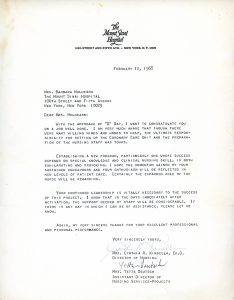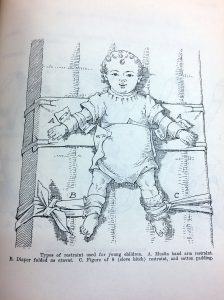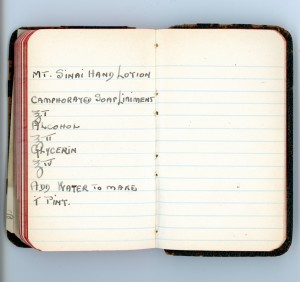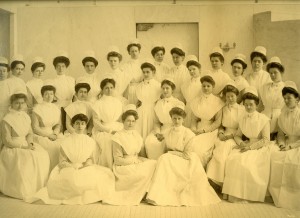Dec 8, 2017
In October of this year, The Mount Sinai Hospital announced the opening of the new cardiac unit, the former Cardiac Care Unit (CCU), now located on KCC 6 in the Klingenstein Clinical Center. There are 20 beds, ten of which are the Cardiac Intensive Care Unit (CICU) and ten are step-down beds, the Cardiac Step Down Unit (CSDU). Unlike the other ICU units, the ten ICU beds are all private rooms. The entire unit is beautiful, with a receptionist desk as you get off the elevator.
It just so happens that last year, the Aufses Archives received a small set of papers from Barbara McPeek Mulhearn, RN, Class of 1962 of The Mount Sinai Hospital School of Nursing. Among those items was information about Mulhearn’s role in creating the first Cardiac Care ICU at the Hospital, which opened in 1968. Her title was Assistant Nursing Supervisor in charge of the Ames Coronary ICU, an eight bed unit on the 4th floor of KCC. The Unit opened February 19, 1968.
Shown below are two pieces from the collection: a drawing of a heart held in a person’s hands with the poem “Invictus” by William Ernest Henley typed over it. This was sent to Mulhearn from “her first I.C.C.U. staff,” in appreciation from them “and the many patients you will help along the way.” Also shown here is a letter from Dr. Cynthia Kinsella, the Director of Nursing at The Mount Sinai Hospital at the time, thanking Mulhearn for her efforts and encouraging her as they neared the Unit opening.
Fifty years on, the caring legacy continues.


Jun 8, 2017
The Arthur H. Aufses, Jr. MD Archives recently received a copy of the 1957 Mount Sinai Nursing Department Manual of Nursing Procedures from Gail Singer Lyon, member of the Class of 1962 of The Mount Sinai Hospital School of Nursing. Manuals like these have value because they show what the patient experience and medical care were like then, and they provide a sense of what the duties of a nurse were at a given point of time. The Archives has many such manuals from 1931 up to the present day, and they provide great information on how nursing, medicine, and hospitals have changed over this span.
While the Archives has other copies of this edition of the Manual, what makes this copy special are the extras that Ms. Lyon has included with her volume, from inserts to doodles. The manuals were given to the students to govern their practice when they were in the clinical areas of the Hospital. It includes detailed instructions on everything from Abdominal Binders to Wall Suction, Method of Using. Throughout the Manual, when it is necessary to provide examples using the names of doctors, the procedures referred to them as Dr. Roe and Dr. Moe. The patient is, of course, John or Jane Doe. Ms. Lyon wrote hints and additional information on the pages of her volume, and also inserted forms and updates to the policies.
This post highlights some of those ‘extras’ that make this volume interesting.

This form shows the communications technology of the time. Note the bottom row for how a family would be reached in time of emergency.

A lovely drawing showing how to restrain a child

A doodle, clearly showing a woman wearing a Mount Sinai Hospital School of Nursing cap, with is many pleats in the front.
Oct 18, 2016

New York Times, January 24, 1917
On October 16th, Planned Parenthood of New York reached its 100th anniversary. It grew from a small birth control clinic created in Brownsville, Brooklyn by Margaret Sanger, her sister Ethel Byrne, and Fania Mindell. At the clinic, they distributed birth control, as well as pregnancy planning advice and information. Even though the three women were arrested for distributing obscene material and jailed, their efforts led to changes in the law allowing for birth control and sex education in the years to come. In 1921, the clinic became the American Birth Control League, which changed its name to the Planned Parenthood Federation of America in 1942.
What does this have to do with Mount Sinai? Margaret Sanger and her younger sister, Ethel Byrne, were nurses. Mrs. Byrne graduated from The Mount Sinai Training School for Nurses in 1909. The sisters did not always get along, but they were united in the believe of women having the right to plan their families. Mrs. Byrne protested her sentence and her jail term of 30 days and launched a hunger strike, which brought a great deal of attention to their cause. The hunger strike lasted for five days, and then she was forcibly fed by prison doctors. Mrs. Sanger and women civic leaders, including Anne Van Kirk, the Superintendent of The Mount Sinai Hospital Training School, appealed for her release. The Governor granted the request on February 1st when Sanger promised that her sister would never break the Comstock law again. Byrne was taken to her sister’s house for care, but this episode damaged their relationship. Byrne did not actively participate in the birth control movement after this.
Ethel Byrne’s later years were quiet. She moved to Massachusetts and returned to nursing. She died in 1955. In 1962, Alan F. Guttmacher, MD left his post as Chairman of OB-GYN at The Mount Sinai Medical Center to become the President of Planned Parenthood. The Mount Sinai connection continued.
May 2, 2016
In honor of National Nurses Week, the Mount Sinai Archives would like to recognize that for over 100 years, Mount Sinai nurses have been doing it all, and then some. When she was a student at The Mount Sinai Training School for Nurses, Class of 1917, Sybil E. Elzas created a little notebook containing important things she needed to know on her clinical rotations, and then once out on her own as a graduate nurse. (Most professional nurses at this time still did private duty nursing, not hospital work.) The notebook was sized just right to slip into the pocket of her uniform’s apron. After pages and pages of definitions of terms and lists of operating room tray set-ups and dressings, towards the back of the book is a lone page noting the recipe for “Mount Sinai Hand Lotion.” Why purchase something nurses could so easily make, and at reduced cost?!
Nurses, still making a difference at Mount Sinai, 100 years later.

Inside cover of the clinic notebook belonging to Sybil E. Elzas. She is shown here as a student while on rotation to Sloane Hospital. The recipe for the lotion is at the end of the volume.

Nov 10, 2015

The Class of 1905, where the first Nancy was a student.
This week I spent some time looking for an early graduate of The Mount Sinai Hospital School of Nursing. An email about the alumna, Nancy Morris, said she graduated from the School in the late 1890s. As I scanned the class lists trying to find the exact year of her graduation, I found many names that seem distinctly old-fashioned, but no simple Nancys. There was a Josepha, many Adas and Idas, an Alphasine, a few Mauds and Daisys, a Mehitable, an Igogereth, quite a few Minnies and Mabels, a Mynolia, and some Florences. It was 1905 – 24 years into the School’s history – before I found the first Nancy, and they were few and far between for quite some time after this.
Just as an FYI, the most common name in our School of Nursing up until 1910 was Mary. This did not even make the top 50 girls’ names in 2013, according to Parents magazine.









